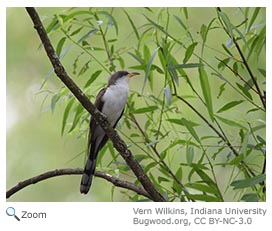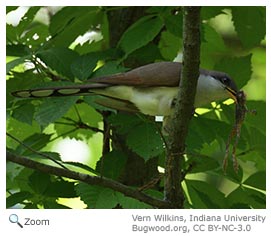Yellow-billed Cuckoo - Coccyzus americanus |
|||||||||||
Description
The underside of its tail is dark brown and has two rows of large white spots. It has a down-curved bill that is black on the top and yellow on the bottom and a ring of gray skin around its eyes. It is grayish-brown on its head and back and has a rusty-red patch on its wings. It has a dull white breast and belly. Males and females look alike, but females are a little larger. Range | HabitatThe yellow-billed cuckoo is found in open woodlands and forested streams with dense, low vegetation. It is often found in orchards, overgrown pastures, abandoned agricultural fields, shrublands, and thickets. Diet
Life CycleBoth the male and the female yellow-billed cuckoo build a nest of twigs, roots, leaves, grass, and pine needles low in a tree or bush. The female lays 2-4 eggs, and both parents incubate the eggs for 10-13 days. Both parents feed and care for the chicks. The chicks leave the nest in 7-9 days and fly when they are 21 days old. The female yellow-billed cuckoo sometimes lays her eggs in the nest of another bird. BehaviorSome people think the yellow-billed cuckoo calls out more on rainy days, so it is sometimes called the "rain crow." |
||||||||||
Audio Credit: xeno-canto.org Scott Olmstead |
|||||||||||



 The yellow-billed cuckoo breeds
from the Great Plains to Texas and east to the Atlantic Coast states. It is also found in scattered locations in the western United States. It winters in South America.
The yellow-billed cuckoo breeds
from the Great Plains to Texas and east to the Atlantic Coast states. It is also found in scattered locations in the western United States. It winters in South America. 